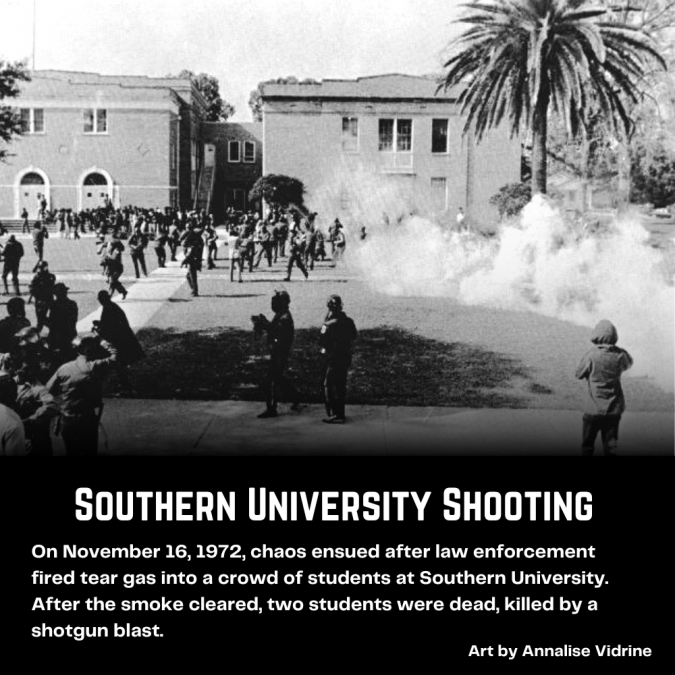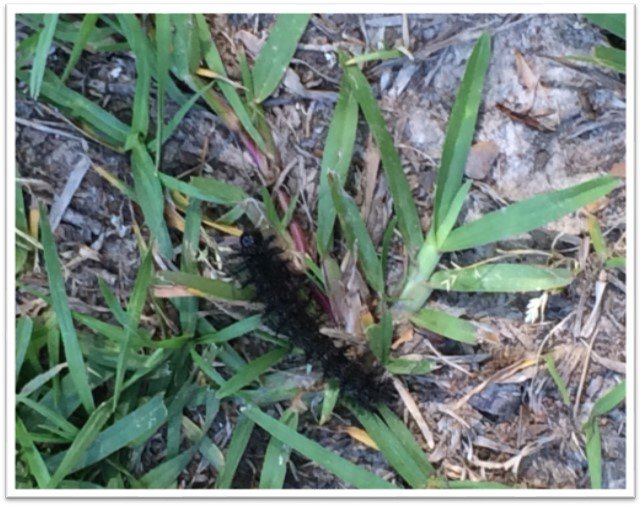
JA of Houma’s Krewe of You to Host Sensory Safe Mardi Gras Event
November 2, 2022
Two arrested, One still wanted for involvement in shooting death in September
November 2, 2022By Drew Hawkins, Adrian Dubose, Maria Pham and Annalise Vidrine, LSU Manship School News Service
Second in a four-part series
The knock on the door came at 4 a.m.
Rickey Hill and Herget Harris, two protest leaders at Southern University, peeked out and saw sheriff’s deputies outside their apartment.
Hill had been arrested the week before for disrupting the campus. Now, on Nov. 16, 1972, the deputies were looking for Harris and others in their Students United protest group.
Harris jumped out a rear window to avoid detection. After the deputies left, he and Hill learned in a hurried calls that Fred Prejean, a 25-year-old community activist, and three other students were being taken to jail.
Hill and Harris decided to ask Southern’s president, George Leon Netterville, to secure the students’ release. As they and their supporters walked toward the two-story brick administration building around 8 a.m., students ran up to find out what was going on.
“So they followed,” Harris said, and “the following grew as we continued on.”
By 8:30 a.m., 75 students were outside the building – some members of Students United, others just curious onlookers. Netterville, who was fed up himself after weeks of demonstrations and boycotts over the quality of education at Southern, agreed to let Hill, Harris and three others into his wood-paneled office.
Hill did the talking, asking Netterville to call the East Baton Rouge Parish Sheriff’s Office and get their classmates out of jail.
Netterville said later that he made it clear he would not act under duress. But before he left for a meeting downtown, three of the students insist – and a Southern official later confirmed – that Netterville said he would see what he could do.
“There was nothing unusual about the look on his face,” Hill said. “We took him at his word.”
Campus security officials, however, viewed the situation much more ominously – and had already called the sheriff’s office several times to ask for help in dispersing the students, according to summaries of interviews in nearly 2,700 pages of FBI files obtained by the LSU Cold Case Project.
In one call, a Southern official reported that 40 to 50 students had followed Hill and Harris into Netterville’s outer office, prompting the president’s staff to barricade him in a nearby room before guards escorted him to his car.
Law-enforcement officials first thought Netterville had been taken hostage. And once they realized he had left the campus, they began assembling a force to drive the students from the building.
Soon, 85 sheriff’s deputies and state troopers armed with shotguns, rifles and tear gas would arrive on campus, heightening the chance for a violent confrontation.
The crowd of students outside the building swelled to about 150 as protest leaders waited inside for Netterville to return. Southern officials did not warn the students that they had called for such a forceful response, an oversight that a gubernatorial commission would later conclude was a recipe for disaster.
Students who were not involved in the protests also were drifting onto the scene, including two 20-year-old juniors who were more focused on their schoolwork.
Leonard Brown had just finished a breakfast of grits, eggs and bacon with his girlfriend,
Rosie Taylor, in the dining hall across from the administration building. He was wearing the blue training uniform of the National Society of Pershing Rifles, a military-style honor society. Taylor had braided his hair the night before to keep dirt out of it during the group’s training exercises.
Denver Smith, a computer science major, had finished his only class for the day and stashed his backpack on the commuter bus he rode to and from New Roads.
It was around 10:00 a.m. and chilly, and the sun was coming out, as he walked over to see what was going on, possibly thinking that his younger sister, Josephine Smith, who supported the protests, was in the crowd.
‘Keyed up’ by the frantic calls
When Mike Barnett woke up that morning, he grabbed his .30-caliber rifle, helmet and flak jacket and got in his cruiser to drive to the parish prison, just down the road from Southern.
By 8:00 a.m., he was having coffee and donuts with other members of the sheriff’s new “tactical team” – a specialized unit that had just started to receive training in crowd control. Deputies were playing cards in a small building called the junior deputy hut and tossing a football to pass the time.
Since the protests started in mid-October, they had been called to Southern twice.
“We’d wait until people out on Southern’s campus told us they were beginning to form a crowd,” Barnett said in a recent interview. “And then we would move from the junior deputy hut out to Southern.”
So far, the deputies had been placed on standby three other times but had not had to deal with anything worse than students shouting insults. State and federal investigators later found that the deputies remained woefully unprepared for a bigger confrontation.
Sheriff Al Amiss, who had just been elected earlier that year, arrived at the hut sometime after 9 a.m., just as his top deputies were fielding increasingly frantic calls from Southern officials. Even as they reported that Netterville was safe, FBI records show, the Southern officials stated – falsely, as it turned out – that a campus guard was being held hostage. The officials kept asking how long it would be before the deputies got to campus.
Barnett and the tactical team were pulling on their gear.
“We’re certainly more keyed up because we knew something had happened and a confrontation would in all probability occur when we got there to get them out of the building,” Barnett said, referring to the students.
A 30-man State Police tactical squad was on the way, and top sheriff’s officials radioed more deputies, called up reservists and pulled guards from the prison.
Dalton Honore, a Southern graduate and the first Black deputy hired by the department, overheard the chatter on the radio and, like some other deputies, brought his own gun from home. Department policy allowed that at the time. Another deputy was getting his truck fixed at a muffler shop when he responded to the calls.
Deputies were divided into squads in front of the junior deputy hut, and most of the officers with shotguns carried both tear gas and buckshot cartridges. The cartridge shapes were identical but were different colors – light blue for buckshot, light green for tear gas.
In an interview with the FBI, Amiss said he told the men not to harm the students, and his deputies briefed those with shotguns on the rules: Load the tear gas into the storage magazine first, followed by the buckshot. And never push live ammunition into a gun chamber unless ordered to do so or you feared for your life.
At 10:10 a.m., the deputies loaded into cars and rolled out from the prison with the State Police. Leading the convoy was a bright blue, armored vehicle that the State Police called “Big Bertha.” It could fire tear gas grenades from a cannon mounted on top.
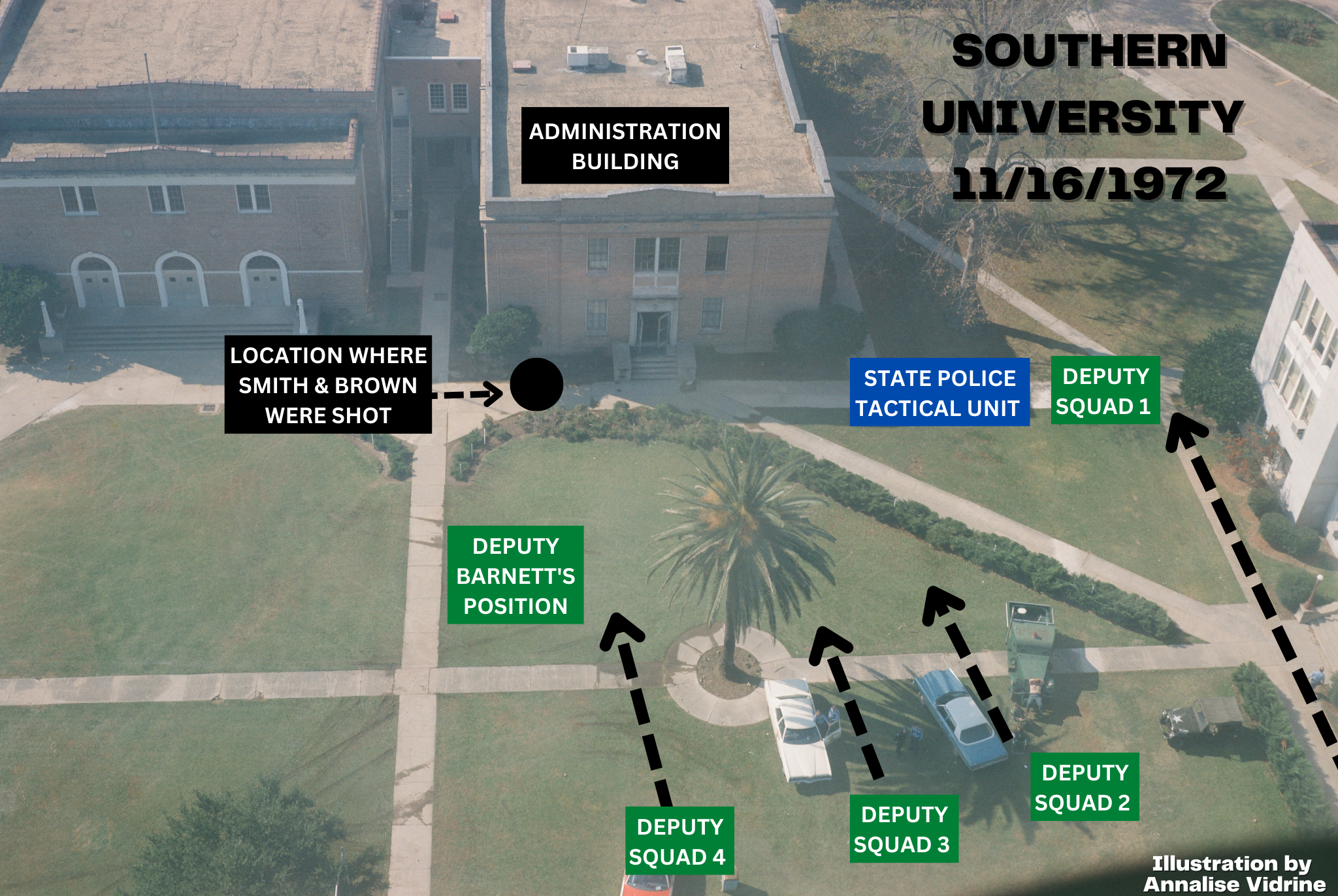
Photo 2 caption: Illustration shows the locations of the State Police tactical unit and four squads of sheriff’s deputies as they moved into their positions on Nov. 16, 1972. This photo, taken after the confrontation, also shows where Denver Smith and Leonard Brown were shot. Courtesy of Louisiana State Police
Lining up near the palm tree
At 10:30 a.m., Rickey Hill and Herget Harris were sitting in Netterville’s office when they heard a commotion outside. They went to the window and saw police cruisers and Big Bertha screech to a halt in the street in front of the building.
Officers in riot gear spilled out of the vehicles, formed up and started jogging in single file down a sidewalk toward the building.
“We were perplexed,” Hill said in a recent interview. “We had no idea what was going on.”
Hill, Harris and the other male students moved outside while Josephine Smith, Rosie Taylor and the other female students gathered inside, thinking they would be safer there.
“We sat on the steps thinking that, you know, once they saw us outside the building, they wouldn’t do anything,” Hill said. “But we were apparently naive about that.”
State troopers in their dark blue uniforms and body armor took up positions in front of an academic building to the students’ left.
Three squads of deputies formed a line across a lawn in front of the administration building, about 75 to 100 feet from the students. Wearing flak jackets and helmets with peaked visors that obscured their faces, the deputies formed an arc behind a large palm tree in the center of the lawn, their shotguns and rifles gleaming.
At 10:32 a.m., a voice boomed out of Big Bertha’s loudspeaker:
“This is Sheriff Amiss of the East Baton Rouge Parish Sheriff’s Office. I’m ordering you to disperse. I’m giving you five minutes to clear the area and leave the building.”
The thin and energetic Hill and the well-built Harris, who wore a distinctive military-style helmet liner, were easy to recognize. Many of the deputies had seen them at previous demonstrations.
Hill and Harris told the students to stay put, but some got up and left.
“You now have two minutes,” Amiss announced over the loudspeaker.
The rest of the students remained defiant as time expired. Some held up their fists in the “Black Power” salute. Officers told the FBI that said other students shouted obscenities at them and yelled, “Come and get us.”
Still, both Barnett and Honore said the students, who were unarmed, did not appear to be threatening.
“I didn’t see a single student break the law other than trespassing in the building,” Barnett said.
The troopers marched up close to the edge of the administration building. Barnett was in one of the squads of deputies on the lawn in front of the building. They started inching forward past the palm tree, moving slowly to keep in line. Some deputies were now just 40 to 50 feet from the students.
At this point, Amiss told the FBI, he thought it was still possible to clear the building without having to arrest the students, and he started moving toward the front of the deputies’ line to make another announcement.
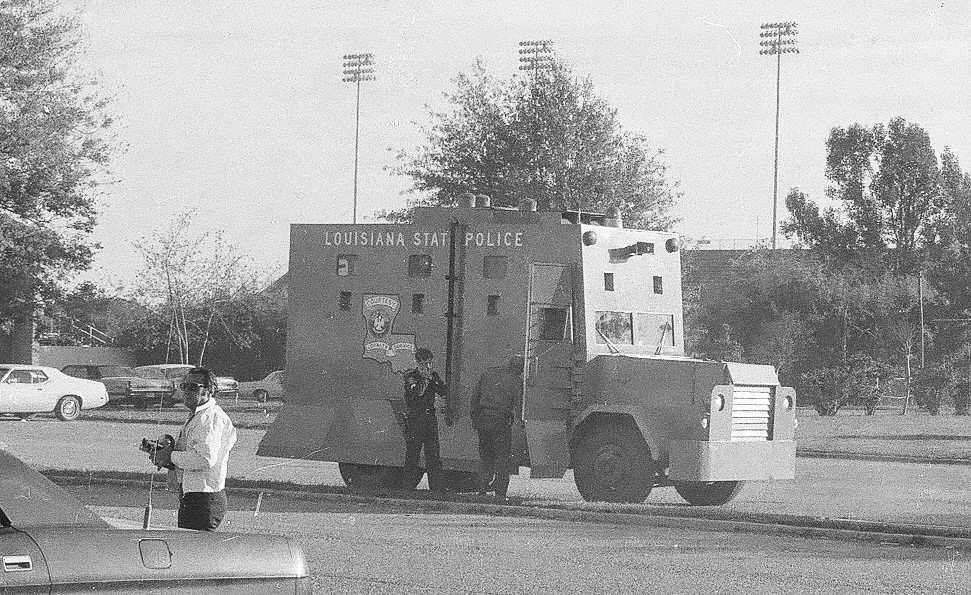
Photo 4 caption: On Nov. 16, a State Police armored vehicle called “Big Bertha” fired 13 tear gas grenades toward student protestors. This photo of the vehicle was taken on Nov. 9 when sheriff’s deputies arrested two students on campus. Courtesy of Louisiana State Police
Then ‘all hell broke loose’
At about the same time, a state police captain approached the left front corner of the administration building, also to make another plea for the students to leave. They refused.
“Looks like we’ll have to gas them,” he told his men.
At 10:39 a.m., Barnett saw the State Police start to put on their gas masks. A moment later –without warning the sheriff’s deputies – a trooper pulled the pin on a tear gas canister and rolled it toward the students. He had mistakenly thought the captain’s comment was an order.
Thick, white smoke billowed out of the canister. A student picked it up and tossed it back. It had a defective fuse and exploded in mid-air, showering the troopers with tear gas before some of them could finish sealing their masks.
Then, as one deputy would later say to the FBI, “All hell broke loose.”
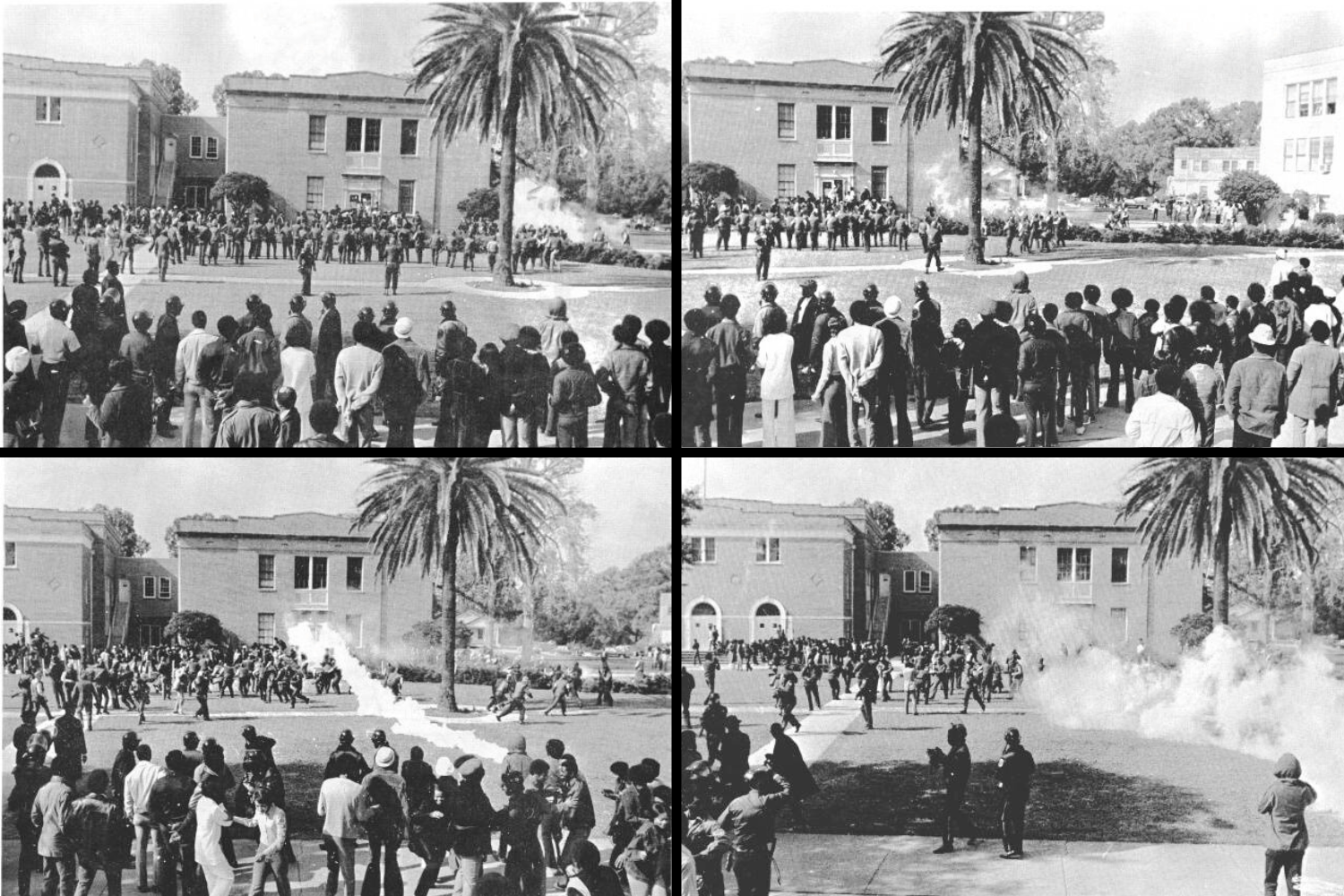
(Top row, left to right) As bystanders watched from the rear, the confrontation began when a State Police officer rolled a tear gas canister toward students, and a student threw it back, with the gas exploding over the heads of State Police. (bottom row, left to right) After a State Police officer tossed a second gas canister, a student threw it back at the sheriff’s deputies in front of the palm tree, forcing many to scatter as they tried to don their gas masks. A gubernatorial commission determined that Denver Smith and Leonard Brown were shot close to the bush near the wall of the administration building moments after the photo was taken. Courtesy of SU Archives
State police threw more canisters, and students threw them back, with the second one exploding over the deputies’ heads.
Some of the officers had not seen the trooper roll the first canister and believed the students had started the attack. Some deputies scrambled to put their masks on, but many did not. The squads broke apart as unmasked deputies, blinded by the gas, coughed and choked and retreated past the palm tree and toward the street.
Big Bertha’s cannon opened up, firing 13 gas grenades at the building in rapid succession. Some of the shells broke through windows, filling the rooms inside with gas.
Several deputies fired tear gas shells from their shotguns. The air was so thick with gas it was difficult to see. The noise was overwhelming. Some deputies did not even know who was standing next to them.
The students on the steps bolted to their right, past an auditorium and through an opening that law-enforcement officials had left to encourage students to flee.
Hill sprinted around the corner, ran through a ravine and hid in the woods. As Harris fled, Denver Smith was on his right and Leonard Brown was on his left. The three of them were at the end of a stream of students running away from the tear gas and the officers.
Only a minute or two had passed since the first canister had been rolled and Big Bertha and the deputies had started firing tear gas shells.
Barnett heard a louder shotgun blast ring out. He said in the recent interview that it came from behind him to his right – from an area in front of the palm tree.
Smith and Brown fell to the ground. Many of the officers did not even see them fall. Others thought they had tripped. But something didn’t look right.
“When they’re running and the shot goes off, they both fall forward,” Barnett said. “And they don’t even try to catch themselves.”
Honore added that with the tear gas in the air, “they just looked like mannequins, you know, just laying on the side.”
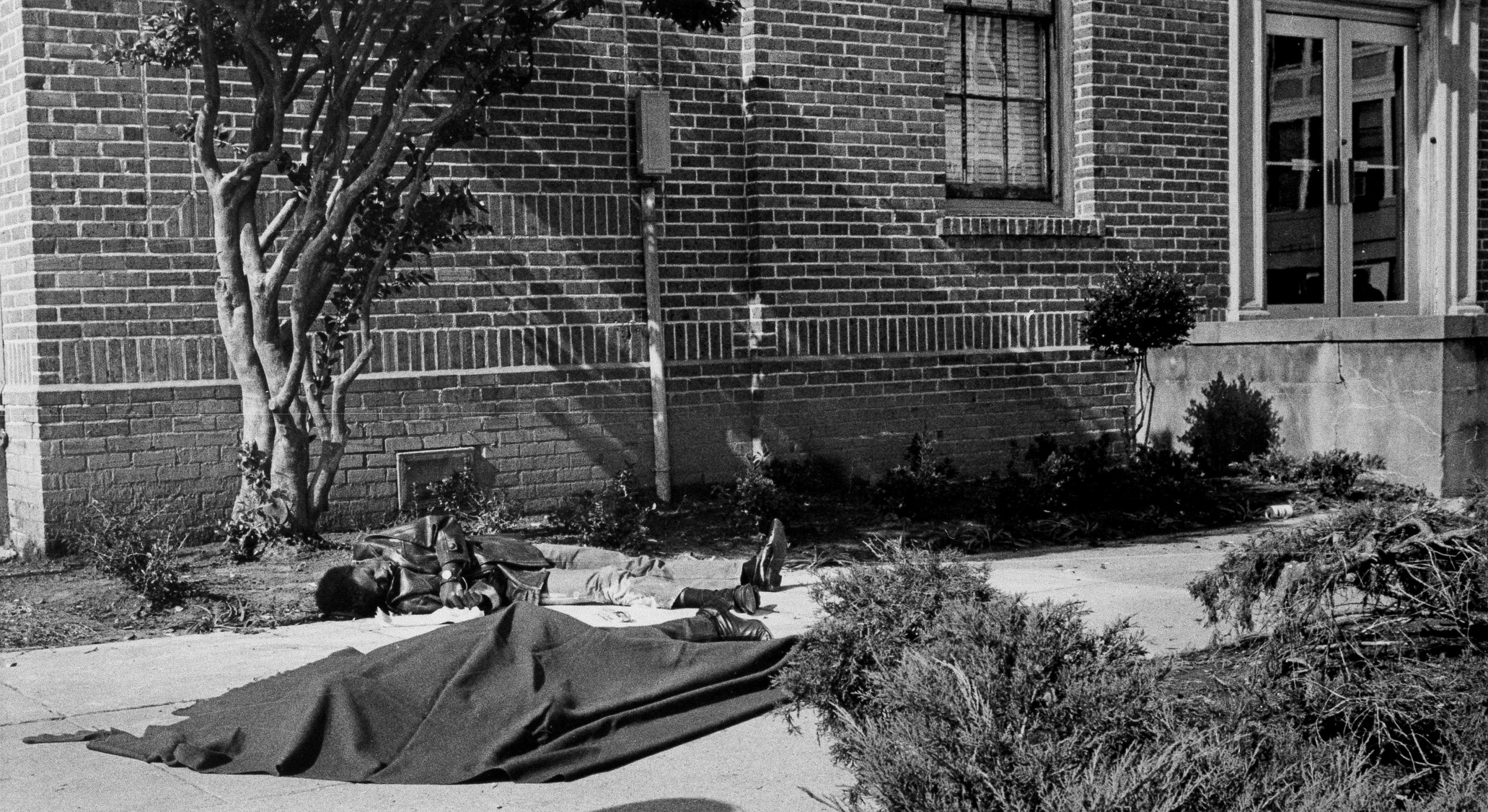
Photo 5 caption: The body of Leonard Brown lay covered on the sidewalk while Denver Smith’s lay close to the bush in front of the building as authorities waited for ambulances to arrive. Courtesy of Associated Press
‘Why? Why?’
In the administration building, where Josephine Smith, Rosie Taylor and the rest of the female students were taking cover, windows had shattered, showering them with glass. Tear gas filled the rooms, and they struggled to breathe.
“Someone had a pack of cigarettes,” Smith said, and to block the gas “we’re sticking butts up our nose.”
An eerie quiet set in as the wind swept the tear gas away, and a campus security officer went inside and told the students to evacuate.
Taylor was one of the first to leave. She walked by the bodies lying on the sidewalk but forced herself not to look.
Ambulances loaded Smith and Brown onto stretchers at about 10:55 a.m. Brown was dead. Smith died 20 minutes after he got to the hospital.
The head of campus security called the Louisiana Board of Education, where Netterville was meeting with board members and Gov. Edwin Edwards. Netterville told them two students were dead.
Netterville closed the campus, and students were told to pack up and leave. While she was gathering her books and belongings, Smith and her roommates turned on the news. Her brother’s smiling face flashed across the screen.
That is how she and her family found out.
Brown would not be officially identified until later. But when Rosie Taylor saw footage of the students’ bodies on the news, one of them had braided hair.
“It dawned on me who it was,” Taylor said.
Shortly after the shooting, the school’s registrar office was set on fire, causing more than $200,000 in damage. Edwards called in the National Guard, worried about potential riots, and promised an investigation into how a live round was fired.
In a recent interview, Josephine Smith recalled the question that was on everyone’s mind.
“It was why. Why? Why?” she asked. “Who did this and for what?”
Brittany Dunn, Allison Allsop, Shelly Kleinpeter, Claire Sullivan, Alex Tirado, Oliva Varden, Cayli Pham, and Brea Rougeau contributed reporting. This series is supported by the Data-Driven Reporting Project
Video by Maria Pham/LSU Manship School News Service

